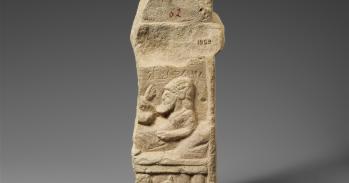
In medieval times Stourbridge Common was the site of one of Europe’s largest fairs – a bustling centre for shopping, eating and revelry, offering temptations of every kind. An Open Cambridge event on Saturday 10 September will tell the fascinating 800-year-old story of Stourbridge Fair.
In medieval times Stourbridge Common was the site of one of Europe’s largest fairs – a bustling centre for shopping, eating and revelry, offering temptations of every kind. An Open Cambridge event on Saturday 10 September will tell the fascinating 800-year-old story of Stourbridge Fair.
Scarce any trades are omitted – goldsmiths, toyshops, brasiers, turners, milliners, haberdashers, hatters, mercers, drapers, pewterers, china-warehouses, and in a word all trades that can be named in London; with coffee-houses, taverns, brandy-shops, and eating houses, innumerable, and all in tents, and booths…
Daniel Defoe, 1724
In the month of September, Stourbridge Common on the outskirts of Cambridge is a lush and pleasant water meadow, frequented by dog walkers, morning joggers and nonchalantly masticating cattle. Scroll back to this very spot several hundred years ago and the air would have been rich with the sounds of tradesmen’s animated chatter, the sawing and hammering of timber, and travelling people tramping down the rough road. Barges and wherries laden with goods would have replaced the sleek college eights skimming the River Cam. Out on the field, carefully measured rows of wooden booths were multiplying, assembling the streets of the most renowned medieval hub of trade, entertainment and revelry: Stourbridge Fair.
For hundreds of years the area known as Stourbridge Common was home to possibly the largest fair of medieval Europe; now all that remains is just a scattering of street names in the east of Cambridge. Garlic row, Mercers Row and Oyster Row are tastes of the huge range of produce bought and sold at this momentous annual event.
The Fair dates back 800 years to 1211, when King John issued a Royal Charter giving the Leper Chapel at Steresbrigge the right to hold a small fund-raising fete. Built on the boundary of Cambridge, the Chapel was part of an abbey that provided care for Cambridge town’s sick and contagious. Growing steadily, the Fair became immensely popular and enticed crowds from all over the country: craftsmen, tradesmen, travellers, nobility, intellectuals, and some of the most famous names in history. For a few weeks a year, it transformed this grazing common into a lively, industrious destination. In 18th century writer Daniel Defoe’s words, Stourbridge Fair became “not only the greatest in the whole nation, but in the world”.
The 800th anniversary of the Fair Charter will be celebrated by a re-enactment on Saturday 10th September, 2011. A grand opening at 12 noon will bring the excitement of Stourbridge Fair back to life in the form of stalls, entertainment and storytelling, all in the grounds of the 12th century Leper Chapel, miraculously still standing. The celebration is one of the many free public talks, tours and events taking place during Open Cambridge, a weekend of discovery for families, local residents and community groups, 9-11 September.
The event will welcome Honor Ridout, Cambridge historian and author of Cambridge and Stourbridge Fair (Blue Ocean Publishing, 2011). Digging into county archives, charters, proclamations, household accounts, trading books and even police reports, Ridout’s book creates a vivid picture of the Fair, using detailed examples and illustrations of the visitors and their lifestyles. She will be giving a talk on the Saturday recounting stories behind the Fair from the 13th to the 18th century.
The Fair’s popularity and development stemmed from its location – alongside both the River Cam which meanders through Cambridgeshire to the Wash at King’s Lynn, and the main road leading to Newmarket. Visitors flocked in their thousands, and its clientele ranged from the most humble peasant to the richest prince in the realm. Royal records show that King Henry III sent his officers to the Fair to buy cloth in 1250. In 1280, his son Edward I bought iron hinges, window bars, fetters and chains for rebuilding Cambridge castle. Author of The Pilgrim’s Progress John Bunyan is said to have modelled his fictional Vanity Fair on Stourbridge, which in turn, is where William Thackeray found the name for his well-known satirical novel.
Queen Elizabeth I stated in a 1589 charter that the Fair “far surpassed the greatest and most celebrated fairs of all England”. Even Isaac Newton visited the Fair during his time at the University, and bought an astronomy book and a pair of prisms, which he subsequently used to experiment with white light splitting into a spectrum of colours.
The rapid assembly of Stourbridge Fair each September required the services of every carpenter in Cambridge, and the participation of builders, agents, auctioneers, bailiffs, accountants, and surveyors among many others. The Fair’s size and scale amounted to that of a small town, complete with housing and amenities. It resembled, as Daniel Defoe described in 1724, “a well-fortified city, and there is the least disorder and confusion I believe, that can be seen anywhere with so great a concourse of people”.
The temporary streets were flanked by wooden booths, which doubled as accommodation; traders often slept on straw mattresses at the back of their stalls as the town was overrun with visitors. A quadrangle of the largest stalls formed a makeshift town square named the Duddery, with a maypole in the centre for music and dancing. Rails and posts were erected in an area assigned for the buying and selling of horses.
Offsetting the worldly concerns of the fair, a pulpit for Sunday sermons was built. Just as the sight of plastic portaloos fill today’s festival-goers with dread, calls of nature were answered with ‘little edifices of general convenience’.
Defoe’s famous journey took him the length and breadth of England. He found Cambridge a rather uninteresting destination, but dedicated several pages of his travel journal to describing his experience at Stourbridge Fair. Locals claimed that one could equip an entire house with the range and volume of produce available at the Fair. Defoe enthusiastically scribbles:
“Scarce any trades are omitted – goldsmiths, toyshops, brasiers, turners, milliners, haberdashers, hatters, mercers, drapers, pewterers, china-warehouses, and in a word all trades that can be named in London; with coffee-houses, taverns, brandy-shops, and eating houses, innumerable, and all in tents, and booths…By these articles a stranger may make some guess at the immense trade carried on at this place; what prestigious quantities of goods are bought and sold here, and what a confluence of people are seen here from all parts of England…In this Duddery, as I have been informed, there have been sold one hundred thousand pounds worth of woolen manufactures in less than a week’s time”.
When the hard work of haggling, dealing and refunding was nearing a close at the end of September, the much-awaited entertainment appeared, and the atmosphere changed to one of indulgence and impishness. Freak shows parading ‘giants’ and ‘faeries’, menageries of wild animals, pigs and dogs solving amusing questions of fortune or arithmetic, waxwork and puppet shows, and astronomical clocks all amazed and enraptured audiences.
From the 13th century onwards, Stourbridge Fair was the biggest trading event locally and beyond. Many of the tradesmen formed a strong community which returned each year, even giving each other silly nick-names such as Nimble-Heels and Stupid Stephen. Young people attended for the social opportunities, enjoying dances, concerts and theatres, mingling in the hope of either procuring a partner or else indulging in some innocent coquetry. Unknown and lovesick poet ‘Mr Travis’ wrote, “TO THE FAIR UNKNOWN, Upon seeing her in the Music Booth at Sturbrige fair”. However the Fair also attracted a darker underbelly – beggars, thieves and prostitutes all congregated, hoping to acquire a portion of the wealth beneath the eyeline of bustling traders and customers.
However, there was one powerful institution dissatisfied with the customer service. The University of Cambridge was quick to recognise not only the disruption, but also the money-making opportunities generated by the Fair. Tensions heightened between ‘Town’ and ‘Gown’ as both parties struggled to assert their administrative rights.
Queen Elizabeth I intervened in 1589, to decree that the Cambridge Corporation (the Town council) should run the Fair, with the University retaining the right to police weights and measures. A squad of University Proctors gladly exploited this opportunity to interfere – they imposed a large number of regulations on tradesmen and violations resulted in large fines. Representing all that was sinful and distracting for students, the entertainment was specifically disapproved of. In 1740, the Vice-Chancellor ordered the Theatre Booth to be demolished, gambling ‘games’ such as Roly Poly and The Colour Board to be carefully monitored or banned altogether, and even entertainers to curb their acts.
As always, those who made rules often broke them; University officials disregarded the prohibition of the Fair’s ‘idle games and diversions’ listed in James I’s charter. In the 1780s, Vice-Chancellors spared no expense in ordering the same menu each year: herrings, neck of pork, round of beef, goose, plum pudding and apple pie, and dined in a private, tiled booth. In the 1790s, the Master of Emmanuel College Dr Richard Farmer was regularly spotted guffawing in the front row of the Critic’s Row at the Playhouse of the Fair. Reports claim that Masters of Arts, Fellows and clergymen were often seen drunkenly singing and linking arms as they stumbled through the Duddery.
After several weeks of trade and festivities, this transient settlement was dismantled. Centuries before the mud-coated piles of cheap plastic tents and sticky aluminium cans which are left behind at Glastonbury, Defoe writes: “And in less than a week more, there is scarce any sign left that there has been such a thing there, except by the heaps of dung and straw and other rubbish which is left behind, trod into the earth, and which is good as a summer’s fallow for dunging the land.” The site was abandoned; tradesmen counted their cash, packed up their horses, and left by coach, wherry or foot, to return the following year.
By the 18th century, the Fair had peaked and was in decline. As urban development spread, permanent town shops took over from markets as the most popular way to trade goods. Expanding railways and road bridges meant that Stourbridge Common – being next to the river – had lost its advantage of a convenient location. The last Fair was held in 1933 and consisted of just one lonely youth with an ice-cream barrow. It was formally abolished in 1934.
The Open Cambridge event, Stourbridge Fair at the Leper Chapel will take place at Barnwell Leper Chapel, Barnwell Junction, Newmarket Road, Cambridge, CB5 8JJ on Saturday 10 September, 12noon to 4pm. It is a drop in event, suitable for all ages. Regrettably, due to its historic nature the Chapel is inaccessible to wheelchair users.
Cambridgeshire Archives and Local Studies will be displaying historical documents including the lease of a fair booth dating back to 1475, and information about various criminal activities which took place at the Fair which ranged from selling stolen horses to exhibiting a life-sized nude waxwork of a woman.
For more information about Open Cambridge, visit www.opencambridge.cam.ac.uk or call 01223 766766.
Cambridge and Stourbridge Fair by Honor Ridout is published by Blue Ocean Publishing, Cambridge, 2011.
This work is licensed under a Creative Commons Licence. If you use this content on your site please link back to this page.





